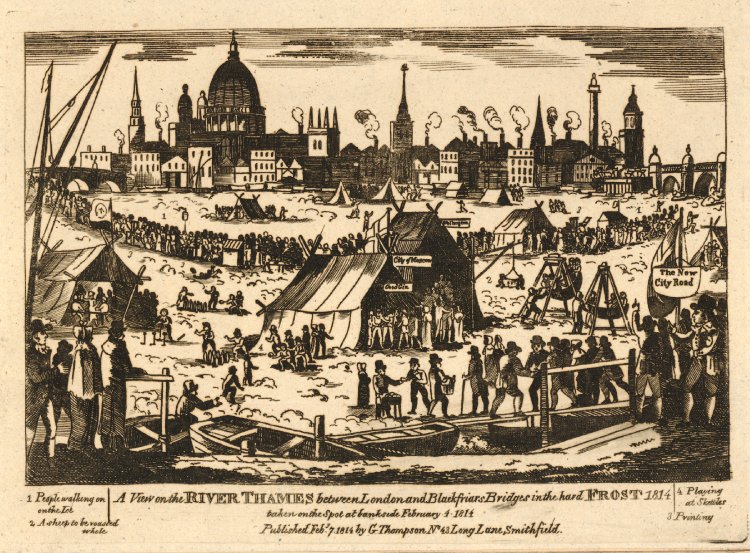![Frost Fair by Luke Clennell [Public domain], via Wiki Commons, https://commons.wikimedia.org/wiki/File:Frost_Fair_of_1814_by_Luke_Clenell.jpg Frost Fair, Luke Clenell, 1814](https://tessajwooldridge.files.wordpress.com/2016/02/frost_fair_of_1814_by_luke_clenell.jpg?w=300&h=248)
I have just begun my own research into London’s Frost Fairs; more particularly, the Frost Fair of 1814. If I step back in time, records show that, for many centuries, sections of the River Thames froze over during winter, sometimes for two or three months at a stretch. In 1410, for instance, The Chronicle of the Grey Friars of London states:
And thys yere was the grete frost and ise, and most sharpest wenter that ever man sawe, and it duryd fourteen wekes, so that men myght in dyvers places both goo and ryde over the Temse.
The Frost Fair of 1683‒84
As the centuries passed, Londoners decided that the frozen river was a good opportunity for fun and frolicking—and for profit. By the seventeenth century, a tradition of Frost Fairs was underway. Possibly the mightiest one took place from early December 1683 to the beginning of February 1684. William Andrews’ Famous Frosts and Frost Fairs in Great Britain describes ‘another city’ that grew on the Thames at that time. There were, he says, a ‘great number of streets and shops with their rich furniture’, a variety of carriages, and ‘near Whitehall a whole ox was roasted on the ice’.

A 1684 broadside titled Wonders on the Deep; or, The Most Exact Description of the Frozen River Thames indicates the range of businesses and activities that flourished on the ice. As well as the horse racing and bull baiting, and the ninepins and skating, the broadside shows rows of shops stretching from Temple Stairs on the Thames’ north bank to the barge house in Southwark—there are coffee houses and beer gardens, toy shops and taverns, and booths selling knives and combs and hot gingerbread. (Hopefully, only empty vessels were available at the booth selling its wares under a flying chamber pot banner.)
The Frost Fair of 1814
Skip forward 130 years. London’s last Frost Fair was held in 1814. (The combined effects of the embankment of the Thames and the design of the ‘new’—and now replaced—1831 London Bridge put paid to further freezing of the river.) The British Museum holds a marvellous engraving, ‘taken on the Spot at bankside’, that shows the activity on the ice on 4 February 1814. Looking north, you can see St Paul’s, the Monument and St Magnus’s overseeing the revelry:


As the frost that had settled in December 1813 rolled into January and then February of 1814, some Londoners’ ardour for their frozen river waned. In response to this disgruntlement, one witty soul printed a directive to Jack Frost (at right):
Historical Fiction
But, I digress. I started this post by acknowledging my growing respect for authors of historical fiction. As a reader, I started my foray into historical novels when I plundered my mother’s Jean Plaidy collection. My Intermediate (Year 10) History teacher allowed her students to bring history texts of their own choosing into class for ‘private reading’ at the end of the school year. I’m fairly sure that Plaidy’s Stuart Saga, beginning with The Royal Road to Fotheringhay, is not what she had in mind, but she indulged me nonetheless. Over the years, I’ve developed a real yen for fictionalised history—especially stories set in the UK. From Edward Rutherford’s London and Sarum to Rosemary Sutcliff’s tales of Roman occupation, from C. J. Sansom’s intriguing Shardlake series to Hilary Mantel’s absorbing Wolf Hall and Bring Up the Bodies, I have roamed across the centuries of England’s changing landscape. Seeing it built, layer upon layer.
My own research into the Frost Fair of 1814 may or may not lead to a work of fiction. It might depend as much on my stamina as my imagination. Although books and documents on the era abound (and they are increasingly accessible due to digitisation), I have at least one new question arising from every piece of information I discover. For example, the Frost Fairs took place in the area just west of London Bridge. I can visually position myself at the base of the bridge, looking south-west. Southwark Cathedral is on my right with Borough Market immediately behind it. But now I learn that the current location of London Bridge is about 55 metres west of the bridge’s 1814 location. (The 1814 bridge had stood since 1209. It was replaced in 1831 and again in 1973.) I need to find out where, exactly, the bridge met the north and south banks of the Thames in 1814. Did it abut the grounds of Southwark Cathedral (then known as St Saviour’s) or did it end closer to St Olaf’s Stairs? Fortunately, there are maps. I’ve even found one that seems purpose-drawn for me: Stranger’s Guide through London and Westminster 1814. At least I can be sure of one thing; Borough Market was not selling llama burgers and ostrich steaks in 1814, as it was on my visit two centuries later. It wasn’t, was it? … Perhaps I’d better check that, too.

Links and Sources:
- Wonders on the deep; or, The most exact description of the frozen river Thames… Printed by M.H. for J.M. for P. Brooksby, at the sign of the Golden-Ball in West Smithfield. And at his shop at the Golden Harp and Ball, near the Bare-Tavern in Pye-Corner: London, 1684
- A View on the River Thames between London and Blackfriars Bridges in the Hard Frost of 1814. George Thompson: London, 1814
- Frost Fair Keepsake. S. Warner: London, 1814
- The Chronicle of the Grey Friars of London. Camben Society: London, 1852
- Andrews, William. Famous Frost Fairs in Great Britain: Chronicled from the Earliest to the Present Time. George Redway: London, 1887
- The History of London Bridge. London Bridge Museum and Educational Trust: London, [2001]
- Stranger’s Guide through the Streets of London and Westminster 1814. William Darton: London, 1814
And for enough source material to last several lifetimes, visit British History Online.







Leave a comment